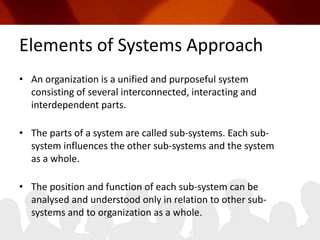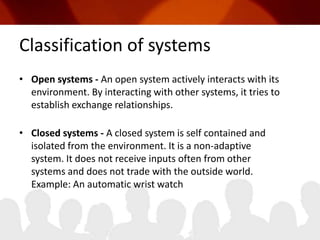Systems Approach to Management
- 2. “Management is the activity of getting things done with the aid of people and other resources”
- 3. “No business in the world has ever made more money with poorer management”
- 5. Systems approach to ManagementIt is a collection of interrelated parts acting together to achieve some goal which exists in the environment. Also, system is defined as a set of objects working together with relationships between the objects and their attributes related to each other and to the environment.Therefore, system in simple terms in respect to management, it is a set of different independent parts working together in interrelated manner to accomplish a set of objectives.
- 6. ENVIRONMENTTransformation processinputoutputSystem BoundarySystems approach to ManagementOrganization as a System receives Input, transforms it through a Process for Output and Operates in an Environment (economic, regulatory and other forces)
- 7. Elements of Systems ApproachAn organization is a unified and purposeful system consisting of several interconnected, interacting and interdependent parts.The parts of a system are called sub-systems. Each sub-system influences the other sub-systems and the system as a whole.The position and function of each sub-system can be analysed and understood only in relation to other sub-systems and to organization as a whole.
- 8. Elements of Systems ApproachEach sub-system derives its strength by its association and interaction with the other sub-systems. As a result the collective contribution of the organization is greater than the aggregate of individual contributions of its sub-systems. This is known as synergy.Each system has a boundary that separates it from its environment. The boundary determines which parts are internal to the organization and which are external. For example, employees are within the boundary and creditors; customers are external to a firm.
- 9. Elements of Systems ApproachThe reaction or response of the environment to the output is known as feedback. Feedback is useful in evaluating and improving the functioning of the system.Organizations operate on the principle that they have several alternative ways of doing the same thing or achieving the same goal.
- 11. Classification of systems Open systems - An open system actively interacts with its environment. By interacting with other systems, it tries to establish exchange relationships. Closed systems - A closed system is self contained and isolated from the environment. It is a non-adaptive system. It does not receive inputs often from other systems and does not trade with the outside world. Example: An automatic wrist watch
- 12. McKinsey 7-S ModelThe 7-S model was originally used to analyze both large and small firms by looking at their structure, offering a wider explanation thorough sevenElements: strategy, structure, systems, style, staff, skills, and shared values.
- 13. The Seven ElementsStrategy - Actions a company plans in response to or anticipation of changes in its external environment. It may also be seen as plans for allocation of resources to enable the company’s identified goals.Structure -Basis for specialization and coordination influenced primarily by strategy and by organizational size and diversity. This is also the way that different units in the firm relate to each other.
- 14. The Seven ElementsSystems -Formal and informal procedures that support the strategy and structure. Often internal systems are more powerful than they are given credit for. They are also the procedures and processes that characterize how the work should be done and internal systems used to accomplish the needed performance.Style - The culture of the organization, which consists of two components. One of them is management style, how key managers behave and what they do rather than what they say. It answers the questions: How do they spend their time? What are they focusing their attention on?
- 15. The Seven ElementsStaff -Human resource management, the processes and efforts used to develop managers, socialization, and the shaping of basic management values, It also includes ways of introducing young recruits to the company, and the support given to manage employees’ careers.Skills -These are the distinctive and core competencies of the company, They include the ways competencies are expanded or shifted. This can also be determined from the perspective of core competencies that exist and are developed in the firm.
- 16. The Seven ElementsShared values -Also called super ordinate goals, these are the central believes and attitudes, guiding concepts, and fundamental ideas around which a business is built. Usually stated at the abstract level, they have great meaning inside the organization even though outsiders may not see or understand them. They can be summarized as what extent the company stands for and what it believes in.
- 17. The Seven ElementsMan, MachineMaterial, Method,MeasurementProduct/Services, Profits,Customer & Societalsatisfaction, Other Long-term GoalsOrganizingInputs(Goal Oriented)Outputs(ExternalToOrgnzn.)PlanningStaffingControllingLeadingEXTERNAL ENVIRONMENT(Opportunities, Constraints)
- 18. The Seven ElementsThese seven elements also help estimate the effectiveness of a firm. They are interrelated -- if one element changes, it will affect all the others. For example, a change in human resource systems such as internal career plans and management training has an impact on organizational culture and thus will affect structures, processes, and finally the characteristic competences of the organization. Another example is changes in the structure such as merging sales and marketing that affect the number and quality of new products that the company can launch.
- 19. Advantages of this theoryIt aims at meaningful analysis of organizations and their management.It facilitates the interaction between organization and its environment.It guides managers to avoid analysing problems in isolation and to develop an integrated approach.
- 20. Disadvantages of this theoryOver-conceptualThe approach does not recognize the differences in systems.Systems philosophy does not specify the nature of interactions and inter-dependencies.Unpractical: It cannot be easily and directly applied to practical problems.
- 21. Questions ?
Editor's Notes
- Take a look at this picture and tell me what you see.Most people will answer - I see a man riding a bicycle.Well, That’s true, but I want you to take a deeper look. What else do you see?The next answer I get is: I see a building in the background.In a way that is looking deeper, but I want you to look deeper in terms of perspective. Focus on the man and the bicycle and think about what’s happening.He’s got his helmet on, he’s pushing on the pedals and he’s riding his bicycle.From my perspective, What I see isn’t just a man riding a bicycle, I see a Transportation System. That’s because I look at the picture with a different perspective. It’s called the Systems Approach. Today I’m going to show you how to view things differently using the Systems Approach.This is going to require some Critical Thinking on your part. You can’t just look at the obvious; you have to look at the picture from a different perspective.We have to break this picture of “Man riding a bicycle” down into two groups of information. First we look at the picture from the “Parts and Pieces Perspective” and then we will look at the same picture from the “How it Works Perspective”.




















